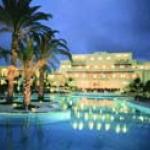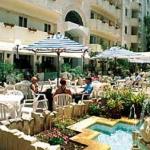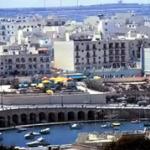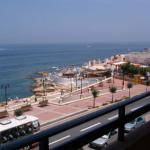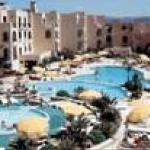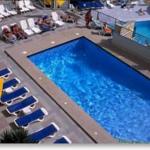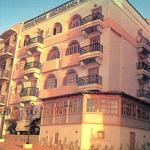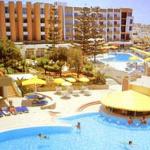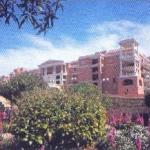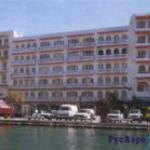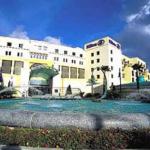Malta Sights
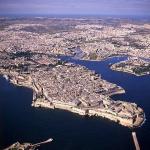 Malta (from the Phoenician "Malet" - "asylum" or Roman "chalk" - "honey") is a unique symbiosis of pure sea, ancient history, beautiful landscapes, quiet coves, steep cliffs and historical mysteries. The entire island of Malta resembles one huge open-air museum. North-east coast of Malta is a huge conglomerate of twenty cities and many smaller settlements. At the same time, the south-west and west, virtually uninhabited, and the southern shoreline of continuous rises sheer rock barrier above the waters of the Mediterranean and almost lifeless.
Malta (from the Phoenician "Malet" - "asylum" or Roman "chalk" - "honey") is a unique symbiosis of pure sea, ancient history, beautiful landscapes, quiet coves, steep cliffs and historical mysteries. The entire island of Malta resembles one huge open-air museum. North-east coast of Malta is a huge conglomerate of twenty cities and many smaller settlements. At the same time, the south-west and west, virtually uninhabited, and the southern shoreline of continuous rises sheer rock barrier above the waters of the Mediterranean and almost lifeless.Valletta - one of the most beautiful cities of the Mediterranean, is one of the few remaining in Europe, the medieval walled cities. Grand Master of the Order of St. John, Jean Parisot de La Valletta began the construction of this fortress in 1566 as a political, economic and cultural center of the Order. The city is unique, here almost every corner of the visitor's waiting for the most interesting cultural and historical attractions. The complex of medieval buildings and defensive structures of most of the modern city, many of them are successfully used in our days, but as various cultural and entertainment facilities. Magnificent views of the old quarters and the Great Harbor "opens with a viewing platform from the heights of the garden Upper Barrakka.
Center city is the Palace of the Grand Master of the Order of Malta (1570-1580 gg.) Is today the residence of the President of Malta and the seat of the Maltese Parliament. No less interesting of Fort St. Elmo, Rikasolli, Saint-Ange-de-Birgu and St. Angelo, the Arsenal of Malta, "the Vault Laskaris," Parisi Palace (now the Ministry of Foreign Affairs), Castilla Palace, the Admiralty (now the National Museum of Fine Arts - the largest collection of paintings in Malta), the beautiful gardens of Hastings near Gate City, Castile and Bavarian inns (1574), Kapellaneriya etc.
Only the Catholic churches on Malta - 365, but a recognized center of the church and a real masterpiece of the art of architecture is the Cathedral of St. John (1573), in the museum which contains unique works of art, and in the chapel houses the famous painting by Caravaggio, The Beheading of John the Baptist's head " . Also worth visiting is the Church of St. Paul's Shipwrecks (1629), the Church of Our Lady Victorious (1565), the church of San Paola de Tarshinov and reconstructed in the twentieth century Church of the Carmelites - an exact copy Kassar was built in 1570 and destroyed Nazi air raids of the church.
History lovers will find in Valletta a few first-class museums - the National Museum of Archeology in the building Oberzh de Provence, the Military Museum at Fort St Elmo and the National Library with a collection of original documents of Malta, as well as the exhibition center "Ekspiriens Malta and the Mediterranean Conference Center in building of the ancient hospital of the Order "Sacra Infermeriya. Always worth a visit Botanical Garden Argotti (XVII cent.), The gardens of San Mason, San Philip in Floriana and the Lower Garden Barrakka the bastion of St. Christoph, as well as the National Theater "Manoel" - one of the oldest theaters in Europe (the first performance - January 9, 1732).
Fused with the capital suburbs Paola, Tarshinov, Zabbar and the "Three Cities - Birgu-feast Vittoriosa, Cospicua and Senglea related fortification" line Kottonera, also rich in monuments of history and architecture. Here are noteworthy church of St. Lorenzo, the Inquisitor's Palace (XII century. Now here Ethnological Museum), the Church of the Immaculate Conception, St. Philip (1651), St. Joseph, St. Mary of Mercy (XVII century.), Maria Bambina or Ile-Redentur "(aka - the Church of Our Lady Victorious, 1743), Sacra-Infermeriya (1531) and St. Lawrence, as well as University and Bishop's Palaces, an underground temple Hal-Saflini or Gipogey, Maritime Museum in the former headquarters of the British Mediterranean Fleet at Fort St. Angelo (Birgu-feast Vittoriosa), Fort St. Michael, hexagonal tower Vedetta or Ile-Gardiol and picturesque Provence gate.
North of Valletta is the busiest tourist and entertainment area of the island - Sliema - St. Julian's - Peysvil. Here at every step, there are restaurants, cafes, bistros, pubs, discos and comfortable hotels, which are so rare in the rest of the island. Another resort area stretches north around St Andrews, St Pauls Bay, Bugibba, Mellieha and Aura Bay.
Mdina, the former capital of Malta - a typical medieval town situated in the heart of the island. The narrow winding streets and medieval houses Mdina preserved to our times almost unchanged. Here and in nearby Rabat (Mdina is separated from the only street Myuzeum Road) are the Cathedral Museum, which displays unique works of art including a collection of works by Durer, who in terms of the shape of the cross of St. Paul's Cathedral (1575), the grotto SW . Paul Norman house or palazzo Faltson, the main gate of Mdina, the Greek Gate, Inguanes palace, the palace of St. Sophia, the Carmelite Church, the Archbishop's Palace, the Museum of Torture, Verdana Palace (1586), with a picturesque park Buskett Gardens, the Roman villa with Museum of Roman antiquity, the Museum of Natural History in the palace of Manoel de Vileny, underground necropolis catacombs of St. Agatha, Issele de Cataldo and St. Paul, an art gallery Cremona, Palazzo Costanzo (XVII cent.) with an extensive collection on the history of medieval and ancient building at Bastion Square.
One of the most picturesque places of the island are Prison Admin-of-Zurrik, famous for its impregnable cliffs and "Blue Grotto", as well as severe steep cliffs of Dingli near Rabat. Marsaxlokk - one of the largest and most picturesque fishing villages in Malta, which operates a lively fish market, full of cafes and secluded off from the set of maritime routes around the island.
Mysterious megalithic sanctuaries in Malta, reminiscent of Stonehenge, are between the ages of 4-6 thousand years. They are unique structures Hajjar, sorrow, Mnajdra, Ta'Hadzhrat, Tarshinov, Tal, Adi, Tas-Sildzh, Al Hassan, Ggantija temple on the island of Gozo, temples, megaliths in Tarksene and Bugibba, cave-museum Har Dalam unique excavation of fossils, as well as carved in stone the mysterious pair of track, crossing the whole island, attracted the attention of both scientists and thousands of tourists trying to find the answer to their appearance. In ancient grotto Al Dalam in Birzebudzhe were also found fossilized bones of dwarf elephants and hippos.
Island of Gozo (Gozo) - the second largest in the Maltese archipelago (area 67,1 square. Kms.). He is more alive and immediate, more peaceful and patriarchal than Malta. Rural areas are preserved its original look - everywhere stretch the field and grove, and large buildings is not even in the capital of the island - the city of Victoria. The only major attraction of Victoria - a huge fortress of the Citadel (chitadella ", XVI cent.) On top of a steep hill, which is still inhabited. In the Citadel located Folklore, Archaeological, Natural Museum and the Cathedral, and the Cathedral exaltation of the Virgin Mary (1697-1711 gg.) And the Chapel of St. Giuseppe. From the heights of the Citadel and the bastion of St. Michael opens a majestic view of the whole island. Of interest are the church of St. Francis, the Basilica of St. George (XVII century.) Bishop's Palace, Palace of Justice, The Crafts Center in the old prison, gardens Randla, as well as lying outside the capital, the megalithic temples of Ggantija (c. 3800 BC. e.) and "Circle Bronshtroffa, a windmill near the town of Xaghra, the legendary cave of Calypso Bay Ramla, vertical sorokametrovy underwater tunnel" Azure Window ", a picturesque rock Fungus Rock about Dueyra Point, the Statue of Christ (21 m in height) in Marsalforna, the Cathedral of John the Baptist in Sheukie, dolmens and cliffs Ta-Cenci, the village of Xlendi and the church Ta'Pinu (1920), with its miracles. Along the coast of Gozo excellent conditions for diving, the best areas are Inlend-C ( "internal sea") is about Dueyra Point (a small lake connected to the Mediterranean Sea by a narrow tunnel in the rock, as well as the Mgarr-in-bus, Xlendi Bay and the cliffs at Giordano lighthouse near Schwinn Bay.
Comino - a small resort island area of 2.8 square. km. features a unique bay "Blue Lagoon", whose incredibly blue water visible from afar. Cominotto (area - 9,9 hectares) surrounds the "Blue Lagoon" by the sea and attracts the attention of a natural tunnel, washed by waves in the rocky grounds of the island. Manoel Island - the only island connected to the "big land" bridge, as well as well-known yacht parking and secluded place of rest, with virtually no inhabited. Filfla Island lies off the southern coast of Malta, on the contrary Bubagra, and is closed to visitors.
The coast is mainly represents the thousands of coves and bays with rocky shores, so Malta - a Mecca for scuba diving: at the bottom of the sea near the island lie the remains of thousands of ships of all time, in the caves and faults inhabit a rich fauna and crystal-clear water allows free pictures of all these marine wonders. There are practically no tides, and the frequent winter undercurrents in the summer are extremely rare. The most interesting places for diving are located in the Ahrash Point on the north-west, Ar-Lapsui on the south shore, Delimara Point in the south-east of Malta, Prison Admin-of-Zurrik and "Blue Grotto", Aura Point in the south of Bay St. Paul, Enker Bay> near the village of Papaya, Chirkeua or Marfa Point and the Maori Marsamshett Harbor Reef Mercanti near Casino in St. Dzhordzhs Bay. Along the coast of Comino interesting caves of Santa Maria and Ir'i'a Point on the south-west. Gozo - Re'a Point, Dueyra, Inlend-C and "blue crack" Blue Hole.
